Long-term monitoring of health inequalities: January 2020 report
Annual update of the long-term monitoring of health inequalities headline indicators.
This document is part of a collection
Inequalities in morbidity and mortality indicators
The relative index of inequality (RII) indicates the extent to which health outcomes are worse in the most deprived areas compared to the average throughout Scotland. While comparisons of RII between indicators are possible, they should be made with some caution, in particular where absolute values are significantly higher or lower in the compared indicators or where the measurement scale differs.
The following charts group indicators in this report into broadly comparable categories: the first shows hospital admissions and incidence of conditions for people belonging to the under 75 age group; while the second shows mortality rates in the 45-74 age group for three causes of death.
Although relative inequalities in heart attack hospital admissions have increased in recent years, inequalities have remained highest in alcohol-related admissions throughout the period covered by this report. Inequalities in cancer incidence have remained relatively stable.
Figure 2.1
Relative Index of Inequality (RII) Selected morbidity indicators (ages <75 years) Scotland 1997-2018
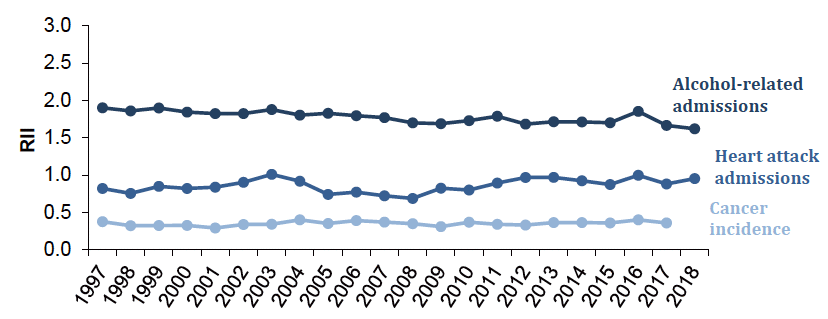
Relative inequalities in CHD mortality among adults aged 45-74 have increased over the long term. Relative inequalities for alcohol-specific deaths have shown more year on year fluctuation over the same period and are currently the lowest in the time series at 1.79.
Although RII in cancer mortality has increased slightly over the longer term, inequalities remain highest in alcohol-specific and coronary heart disease deaths .
Figure 2.2
Relative Index of Inequality (RII) Mortality indicators (ages 45 74 years) Scotland 1997-2018
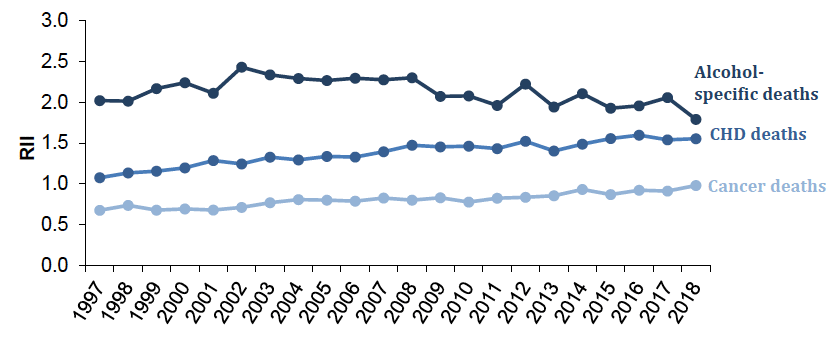
Coronary Heart Disease - first ever hospital admission for heart attack aged under 75 years
Trends in heart attack hospital admissions
In 2018, around 4,200 new cases of heart attack (for those aged under 75 years) were recorded in Scottish hospitals.
The rate of admissions is currently 42% lower than in 1997. Whilst there were increases in the rate of hospital admissions between 2007 and 2012, (rising from 80.4 per 100,000 to 100.8 per 100,000), in 2018 the rate of hospital admissions was the third lowest on record (83.9 per 100,000).
Table 3.1: Trends in heart attack hospital admissions (aged <75), 1997-2018
| Total admissions | Population | Rate per 100,000 (EASR) | |
|---|---|---|---|
| 1997 | 5,764 | 4,740,269 | 145.1 |
| 1998 | 5,676 | 4,729,975 | 141.5 |
| 1999 | 5,101 | 4,721,298 | 126.6 |
| 2000 | 4,812 | 4,708,667 | 118.4 |
| 2001 | 4,776 | 4,703,661 | 116.9 |
| 2002 | 4,833 | 4,701,958 | 116.6 |
| 2003 | 4,569 | 4,702,431 | 109.0 |
| 2004 | 4,413 | 4,714,233 | 103.9 |
| 2005 | 4,047 | 4,735,320 | 94.2 |
| 2006 | 3,750 | 4,752,425 | 86.4 |
| 2007 | 3,549 | 4,783,452 | 80.4 |
| 2008 | 3,655 | 4,811,453 | 81.7 |
| 2009 | 3,851 | 4,835,007 | 84.9 |
| 2010 | 4,377 | 4,858,058 | 95.4 |
| 2011 | 4,537 | 4,888,316 | 97.7 |
| 2012 | 4,747 | 4,895,114 | 100.8 |
| 2013 | 4,697 | 4,903,074 | 98.8 |
| 2014 | 4,503 | 4,914,362 | 93.4 |
| 2015 | 4,521 | 4,935,283 | 92.8 |
| 2016 | 4,521 | 4,962,391 | 91.5 |
| 2017 | 4,738 | 4,976,829 | 94.8 |
| 2018 | 4,233 | 4,983,364 | 83.9 |
Inequalities in hospital heart attack hospital admissions, 2018
In 2018, the admission rate in Scotland's most deprived areas was more than twice that of those living in the least deprived (132.4 cases per 100,000 compared to 55.1 per 100,000).
Figure 3.1
Hospital admissions for heart attack among those aged <75y by Income Employment Index, Scotland 2018 (European Age Standardised Rates per 100,000)
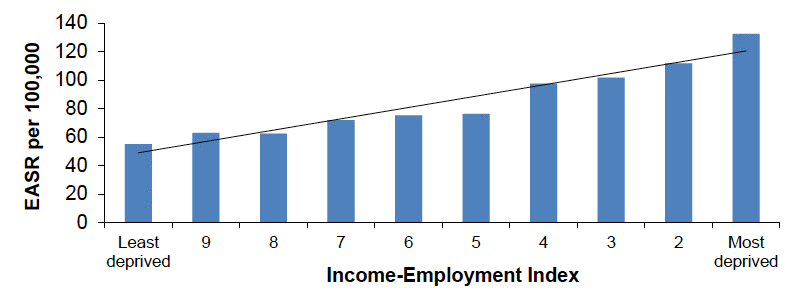
Trends in relative inequalities
Relative inequality levels for heart attack hospital admissions have fluctuated over time, ranging from 0.69-1.01. The RII for 2018 (0.95) is higher than that at the start of the time series (0.82).
Figure 3.2
Relative Index of Inequality (RII): Hospital admissions for heart attack <75y Scotland 1997 2018
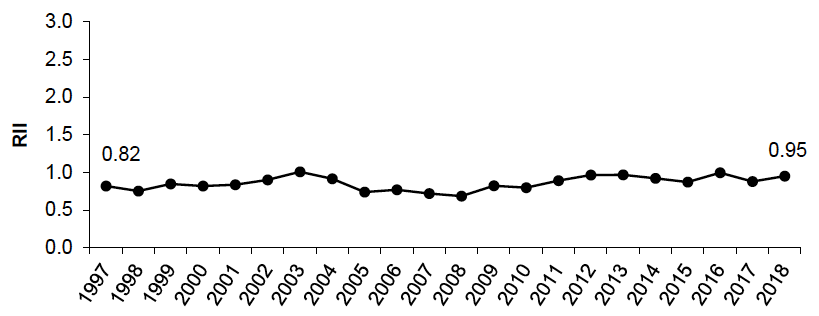
Heart attack hospital admission rates (aged <75) have been 2-3 times higher in the most deprived areas compared to the least deprived areas across the time series. (European Age Standardised Rates per 100,000)
Trends in absolute inequalities
The absolute gap in hospital admissions between those living in the most and least deprived areas was 77.3 per 100,000 in 2018, lower than at the start of the times series in 1997 when the gap was at its largest (114.6 per 100,000).
However, absolute inequalities have fluctuated over that time, with the gap at its narrowest between 2006 and 2008.
Figure 3.3
Absolute Gap: Hospital admissions for heart attack <75y Scotland 1997-2018 (European Age Standardised Rates per 100,000)
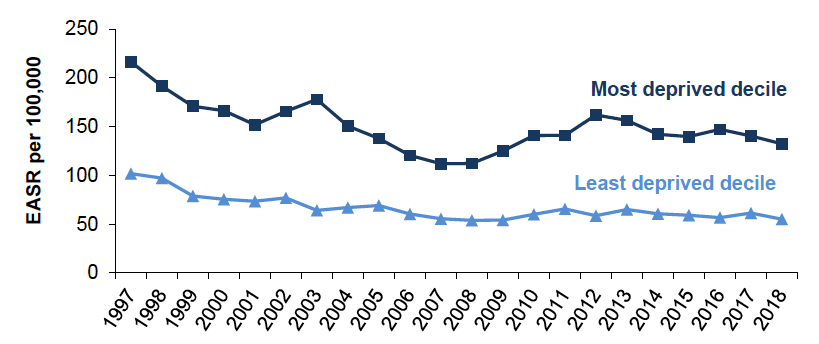
Coronary Heart Disease (CHD) Mortality - deaths aged 45-74 years
Trends in CHD deaths
In 2018, around 2,400 deaths amongst those aged 45-74 years were attributed to CHD.
Since 1997, there has been a considerable decrease in CHD mortality amongst the population aged 45-74 years. In 2018, the death rate for this age group was 117.6 per 100,000, less than one third what it was in 1997 and the lowest figure on record.
Table 4.1: Trends in coronary heart disease deaths (aged 45-74), 1997-2018
| Number of deaths | Target population size | Rate per 100,000 (EASR) | |
|---|---|---|---|
| 1997 | 5,887 | 1,635,590 | 372.5 |
| 1998 | 5,675 | 1,646,711 | 357.9 |
| 1999 | 5,389 | 1,658,124 | 338.9 |
| 2000 | 4,858 | 1,670,660 | 303.9 |
| 2001 | 4,483 | 1,687,422 | 279.3 |
| 2002 | 4,310 | 1,706,141 | 265.9 |
| 2003 | 4,197 | 1,727,112 | 256.3 |
| 2004 | 3,840 | 1,751,037 | 232.3 |
| 2005 | 3,721 | 1,774,865 | 222.3 |
| 2006 | 3,393 | 1,799,382 | 200.8 |
| 2007 | 3,374 | 1,827,320 | 196.6 |
| 2008 | 3,155 | 1,856,874 | 180.9 |
| 2009 | 2,857 | 1,885,693 | 160.7 |
| 2010 | 2,811 | 1,914,226 | 156.6 |
| 2011 | 2,592 | 1,941,253 | 142.6 |
| 2012 | 2,584 | 1,964,203 | 139.7 |
| 2013 | 2,515 | 1,986,202 | 133.7 |
| 2014 | 2,358 | 2,007,988 | 123.1 |
| 2015 | 2,463 | 2,026,210 | 127.4 |
| 2016 | 2,467 | 2,047,858 | 124.7 |
| 2017 | 2,476 | 2,064,612 | 122.2 |
| 2018 | 2,416 | 2,073,318 | 117.6 |
Inequalities in CHD deaths, 2018
In 2018, the CHD mortality rate was more than four times greater in Scotland's most deprived areas compared to the least deprived (219.8 compared to 54.0 deaths per 100,000 population).
Figure 4.1
CHD mortality amongst those aged 45-74y by Income Employment Index, Scotland 2018 (European Age Standardised Rates per 100,000)
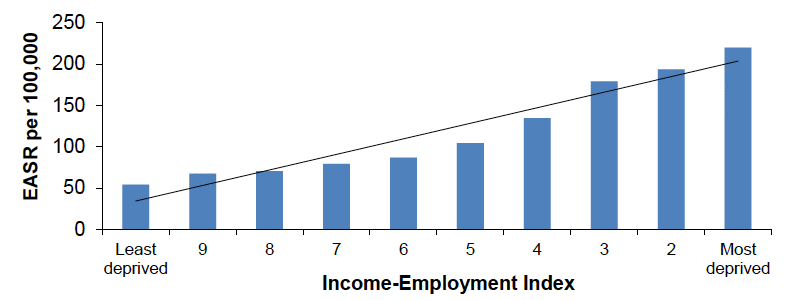
Trends in relative inequalities
Relative inequalities in CHD mortality have increased over the longer term. The RII figures for the last four years have been the highest in the time series, ranging from 1.54-1.60.
Figure 4.2
Relative Index of Inequality (RII): CHD mortality 45-74y Scotland 1997-2018
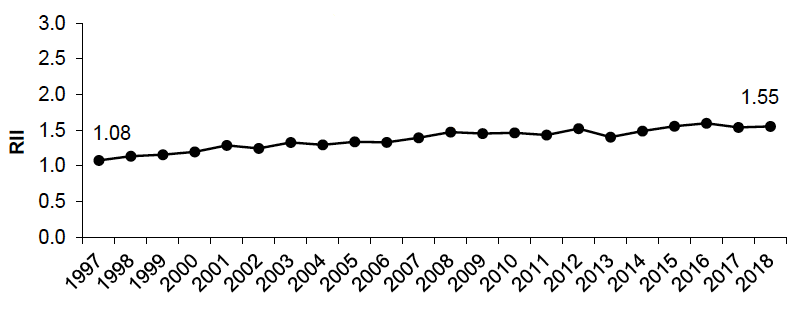
In the last ten years, CHD mortality rates have typically been 4-5 times higher in the most deprived areas compared to the least deprived areas. This is higher than at the start of the times series when CHD mortality rates were typically 3-4 times higher.
Trends in absolute inequalities
In contrast to relative inequality, absolute inequality between those living in the most deprived areas and those living in the least deprived areas has reduced over the longer term from a high of 390.1 per 100,000 in 1998. The current gap is the lowest across the series and less than half what it was in 1998 (165.8 per 100,000 in 2018).
Figure 4.3
Absolute Gap: CHD mortality 45-74 years, Scotland 1997 2018 (European Age Standardised Rates per 100,000)
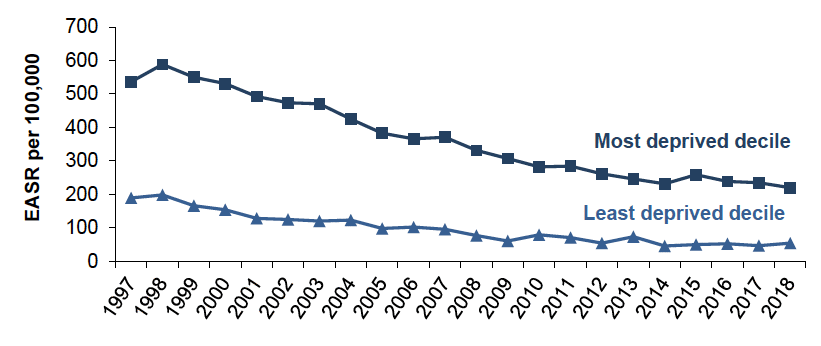
Cancer incidence rate aged under 75 years
Trends in cancer incidence
In 2017, there were around 21,200 new cases of cancer among people aged under 75. Figures for 2018 are not currently available and will be included in the next report.
Cancer incidence among people aged under 75 has fluctuated over the time series. It showed a general decrease from a high of 452.7 per 100,000 in 1996 to 417.5 per 100,000 in 1999, before showing an overall increase until 2009 (446.6 per 100,000). Since then cancer incidence has decreased overall and was 426.5 per 100,000 in 2017.
Table 5.1: Trends in cancer incidence (aged < 75), 1996-2017
| Number of new cases | Target population size | Rate per 100,000 (EASR) | |
|---|---|---|---|
| 1996 | 18,128 | 4,754,906 | 452.7 |
| 1997 | 17,167 | 4,740,269 | 427.4 |
| 1998 | 17,109 | 4,729,975 | 424.3 |
| 1999 | 16,914 | 4,721,298 | 417.5 |
| 2000 | 17,138 | 4,708,667 | 420.6 |
| 2001 | 17,147 | 4,703,661 | 418.9 |
| 2002 | 17,530 | 4,701,958 | 423.6 |
| 2003 | 17,574 | 4,702,431 | 420.8 |
| 2004 | 18,159 | 4,714,233 | 430.3 |
| 2005 | 17,987 | 4,735,320 | 421.9 |
| 2006 | 18,167 | 4,752,425 | 423.3 |
| 2007 | 18,775 | 4,783,452 | 430.8 |
| 2008 | 19,449 | 4,811,453 | 439.7 |
| 2009 | 19,999 | 4,835,007 | 446.6 |
| 2010 | 20,015 | 4,858,058 | 441.9 |
| 2011 | 20,208 | 4,888,316 | 441.3 |
| 2012 | 20,296 | 4,895,114 | 436.8 |
| 2013 | 20,598 | 4,903,074 | 437.7 |
| 2014 | 21,064 | 4,914,362 | 442.4 |
| 2015 | 20,888 | 4,935,283 | 433.5 |
| 2016 | 20,980 | 4,962,391 | 429.2 |
| 2017 | 21,187 | 4,976,829 | 426.5 |
Inequalities in cancer incidence, 2017
In 2017, there were 524.5 cases of cancer per 100,000 people in the most deprived areas, compared to 373.6 cases per 100,000 in the least deprived areas.
Figure 5.1
Cancer incidence amongst those aged <75y by Income Employment Index,Scotland 2017 (European Age Standardised Rates per 100,000)
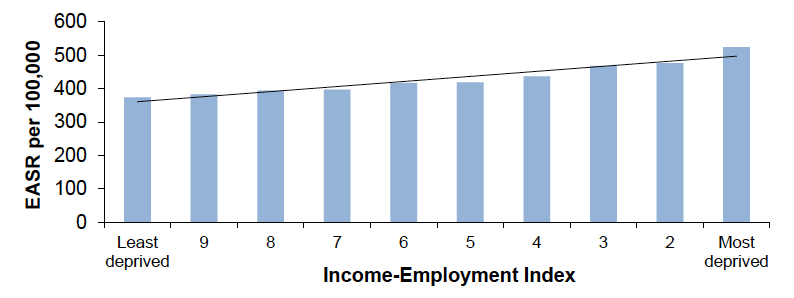
Cancer incidence is more common in the most deprived areas of Scotland. However, this is not the case for all types of cancer[1]. This is driven in part by variations in screening uptake, leading to socially patterned rises in cancer incidence and, in turn, cancer survival for some types of cancer in the least deprived areas.
As has been the case in previous years, of the most common types of cancer, the absolute gap between most and least deprived areas was largest for cancer of the trachea, bronchus and lung (2017 rates were 129.6 and 26.3 per 100,000 population in the most and least deprived areas respectively).
Trends in relative inequalities
Changes in the relative index of inequality over time have been minimal and show no clear pattern, with the rate fluctuating between 0.29 and 0.40.
Figure 5.2
Relative Index of Inequality (RII): Cancer incidence <75y Scotland 1996-2018
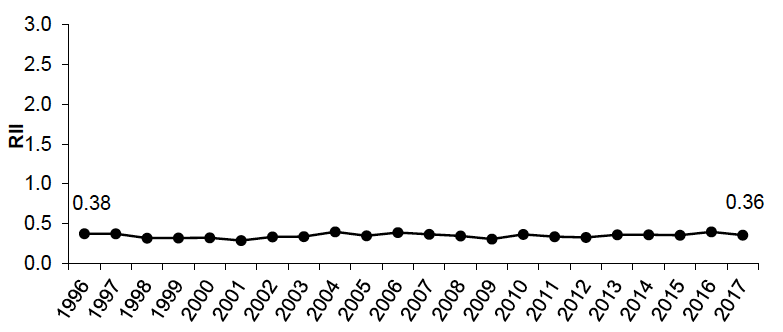
Incidence rates have typically been 30-50% higher in the most deprived areas in Scotland compared to the least deprived (40% in 2017).
Trends in absolute inequalities
Absolute inequality levels in cancer incidence have fluctuated over time, with a gap ranging from 122.1 to 178.2 per 100,000 population. Rates in both the least and most deprived areas of Scotland have shown no clear pattern.
Figure 5.3
Absolute Gap: Cancer incidence <75y, Scotland 1996-2017 (European Age Standardised Rates per 100,000)
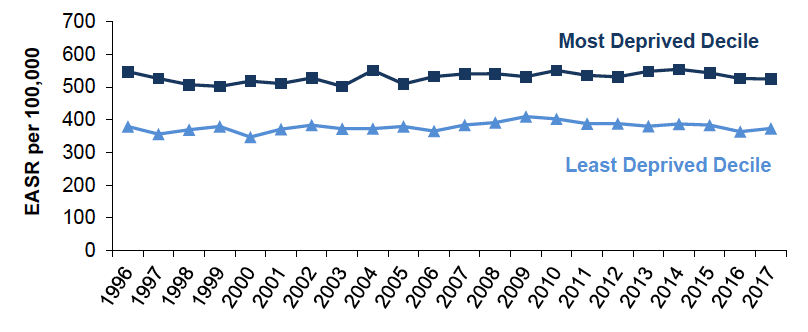
The gap was widest in 2004 (rates of 551.1 per 100,000 and 372.9 per 100,000 in the most and least deprived areas, respectively) but the adjacent years of 2003 and 2005 displayed relatively narrow gaps. The gap was lower in 2017 (150.9 per 100,000) than at the start of the time series (167.7 per 100,000).
Cancer deaths aged 45-74 years
Trends in cancer deaths
The cancer mortality rate amongst those aged 45-74 years has fallen by 31% since 1996 (from 529.8 to 367.0 per 100,000 population in 2018). The number of deaths each year has also reduced in this period, from around 8,400 to 7,500.
Table 6.1: Trends in cancer mortality (aged 45-74), 1996-2018
| Number of deaths | Target population size | Rate per 100,000 (EASR) | |
|---|---|---|---|
| 1996 | 8,402 | 1,631,224 | 529.8 |
| 1997 | 8,068 | 1,635,590 | 509.1 |
| 1998 | 7,995 | 1,646,711 | 501.9 |
| 1999 | 7,904 | 1,658,124 | 494.4 |
| 2000 | 7,776 | 1,670,660 | 484.8 |
| 2001 | 7,903 | 1,687,422 | 489.2 |
| 2002 | 7,850 | 1,706,141 | 481.2 |
| 2003 | 7,706 | 1,727,112 | 467.4 |
| 2004 | 7,678 | 1,751,037 | 460.9 |
| 2005 | 7,606 | 1,774,865 | 451.8 |
| 2006 | 7,486 | 1,799,382 | 441.3 |
| 2007 | 7,569 | 1,827,320 | 439.5 |
| 2008 | 7,536 | 1,856,874 | 431.0 |
| 2009 | 7,481 | 1,885,693 | 421.2 |
| 2010 | 7,394 | 1,914,226 | 411.1 |
| 2011 | 7,428 | 1,941,253 | 408.5 |
| 2012 | 7,514 | 1,964,203 | 406.2 |
| 2013 | 7,520 | 1,986,202 | 399.8 |
| 2014 | 7,445 | 2,007,988 | 389.6 |
| 2015 | 7,621 | 2,026,210 | 392.9 |
| 2016 | 7,385 | 2,047,858 | 373.5 |
| 2017 | 7,342 | 2,064,612 | 363.6 |
| 2018 | 7,531 | 2,073,318 | 367.0 |
Inequalities in cancer deaths, 2018
Of people in the 45-74 year age group, those in Scotland's most deprived areas are more than twice as likely to die of cancer than those in the least deprived areas (556.2 deaths per 100,000 population compared to 235.3 per 100,000 population, in 2018).
Figure 6.1
Cancer mortality amongst those aged 45-74y by Income Employment Index, Scotland 2018 (European Age Standardised Rates per 100,000)
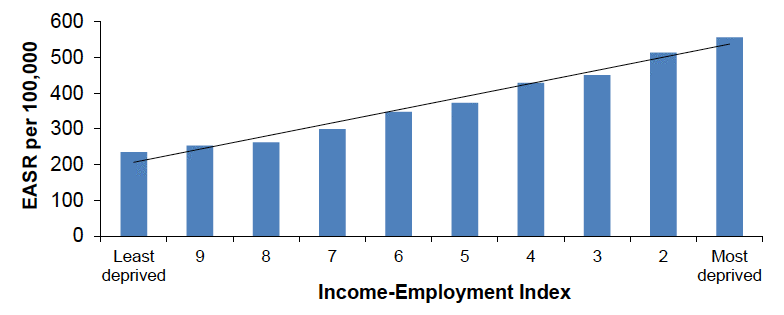
As is the case for cancer incidence, inequality levels vary when examining deaths by cancer type[2]. As described in the previous section, variations in screening uptake may lead to socially patterned rises in cancer incidence and, in turn, cancer survival (therefore having a possible effect on mortality) for some types of cancer.
The largest differences between rates in the most and least deprived areas are again observed for cancer of the trachea, bronchus and lung (191.6 compared to 41.4 per 100,000 population in 2018).
Trends in relative inequalities
Relative inequalities for this indicator have increased over time and the RII in 2018 (0.98) was the highest recorded across the time series. This compares with a range of 0.68-0.81 seen in the years between 1996 and 2006.
Figure 6.2
Relative Index of Inequality (RII): Cancer mortality 45-75y Scotland 1996-2018
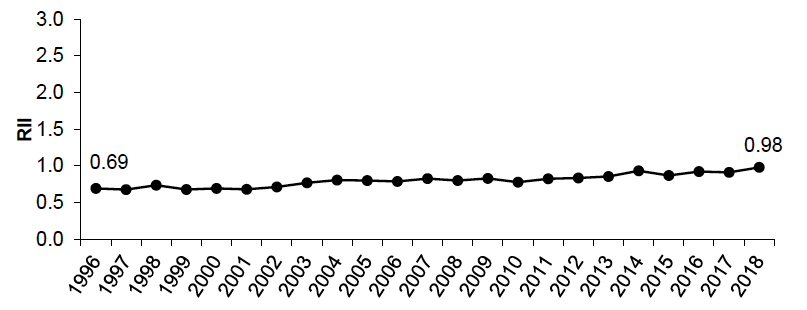
Cancer mortality rates (aged 45-74) have consistently been twice as high in the most deprived areas compared to least deprived areas over the time series.
Trends in absolute inequalities
Levels of absolute inequality for cancer deaths have fluctuated since 1996, with a absolute gap between the most and least deprived areas ranging from 304.8 to 395.3 per 100,000 population. In 2018 the gap was 320.9 per 100,000.
Figure 6.3
Absolute Gap: Cancer mortality 45-74y, Scotland 1996-2018 (European Age Standardised Rates per 100,000)
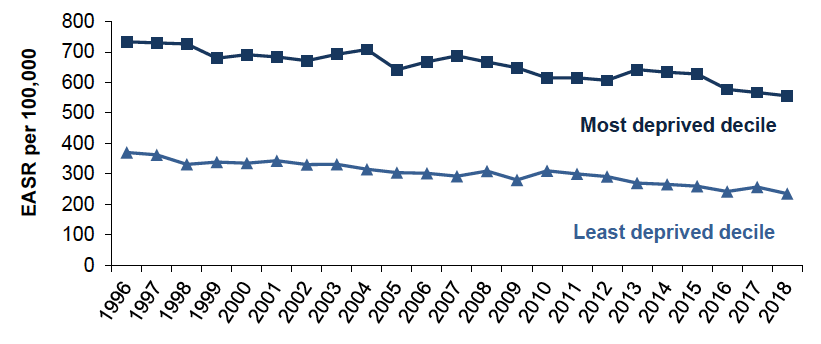
Alcohol-related hospital admissions aged under 75 years
Trends in alcohol-related admissions
The hospital admission rate for alcohol-related conditions amongst those aged under 75 years has fallen over time, with a 25% decrease between 1996 and 2018 (289.8 and 217.5 cases per 100,000 respectively).
Table 7.1: Trends in alcohol-related hospital admissions (aged < 75), 1996-2018
| Number of admissions | Target population size | Rate per 100,000 (EASR) | |
|---|---|---|---|
| 1996 | 12,787 | 4,754,906 | 289.8 |
| 1997 | 12,918 | 4,740,269 | 292.6 |
| 1998 | 13,316 | 4,729,975 | 300.7 |
| 1999 | 13,217 | 4,721,298 | 298.2 |
| 2000 | 12,786 | 4,708,667 | 286.6 |
| 2001 | 13,469 | 4,703,661 | 300.3 |
| 2002 | 13,492 | 4,701,958 | 299.9 |
| 2003 | 12,996 | 4,702,431 | 290.0 |
| 2004 | 14,084 | 4,714,233 | 312.5 |
| 2005 | 13,346 | 4,735,320 | 293.8 |
| 2006 | 13,595 | 4,752,425 | 295.3 |
| 2007 | 14,641 | 4,783,452 | 313.5 |
| 2008 | 14,222 | 4,811,453 | 302.3 |
| 2009 | 12,891 | 4,835,007 | 272.9 |
| 2010 | 12,307 | 4,858,058 | 258.7 |
| 2011 | 12,264 | 4,888,316 | 256.2 |
| 2012 | 11,556 | 4,895,114 | 240.9 |
| 2013 | 11,225 | 4,903,074 | 236.8 |
| 2014 | 10,776 | 4,914,362 | 223.6 |
| 2015 | 10,467 | 4,935,283 | 216.2 |
| 2016 | 10,767 | 4,962,391 | 219.4 |
| 2017 | 10,644 | 4,976,829 | 218.0 |
| 2018 | 10,656 | 4,983,364 | 217.5 |
Inequalities in alcohol-related hospital admissions, 2018
In 2018, alcohol-related admissions were 4 times higher in the most deprived areas of Scotland compared to the least (426.8 compared to 98.6 cases per 100,000).
Figure 7.1
Alcohol related hospital admissions amongst those aged <75y by Income Employment Index, Scotland 2018 (European Age Standardised Rates per 100,000)
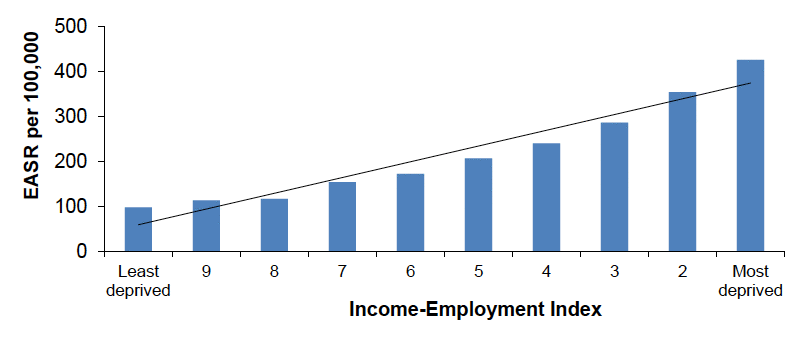
Trends in relative inequalities
There has been a general downward trend observed in relative inequalities for alcohol-related hospital admissions since 1996. However, there has been some fluctuation including an increase in 2016 when the RII was 1.85, the highest rate since 2003. The figure for 2018 is the lowest in the series at 1.62.
Figure 7.2
Relative Index of Inequality (RII): Alcohol-related hospital admissions <75y Scotland 1996-2018
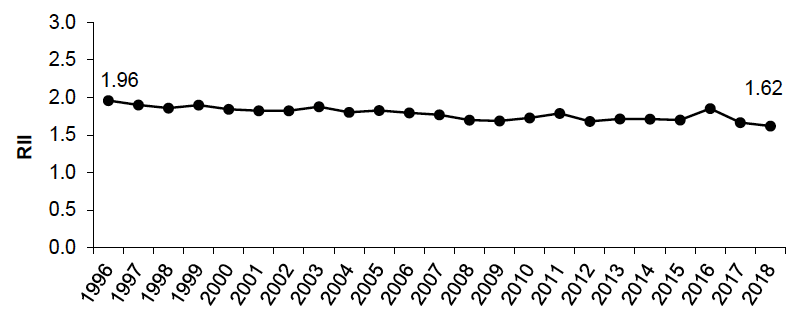
In 1996, alcohol-related admission rates were 7 times higher in the most deprived areas compared to the least deprived. These rates have ranged between 5 and 6 times higher since 2003 and declined to 4 times higher for the first time in 2018.
Trends in absolute inequalities
Absolute inequality in alcohol-related admissions has generally reduced over time, due to a reduction in admissions in the most deprived areas. The gap was widest at the start of the time series in 1996 (613.0 per 100,000) and is currently at its lowest level (328.3 per 100,000 in 2018).
Figure 7.3
Absolute Gap: Alcohol-related hospital admissions <75y Scotland 1996-2018 (European Age-Standardised Rates per 100,000)
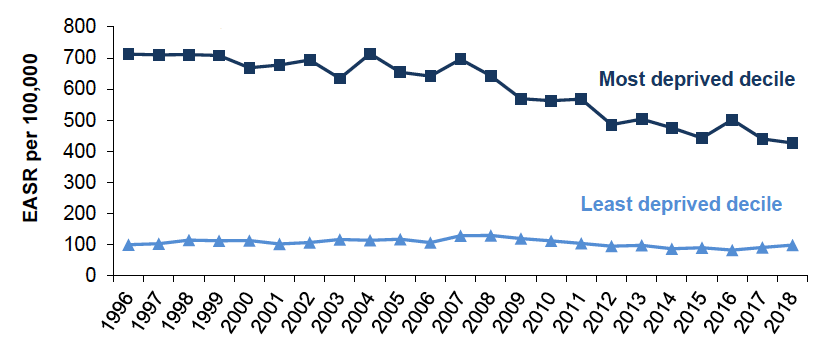
Alcohol-specific deaths aged 45-74 years
Trends in alcohol-specific deaths
The alcohol-specific death rate among those aged 45-74 years has fluctuated over the time series. There was an overall increase between 1997 and 2006 (increasing from 38.5 per 100,000 to 61.3 per 100,000) followed by a general downward trend until 2011 (38.2 per 100,000) when the rate was similar to the start of the time series. Since 2011, the alcohol-specific mortality rate has increased slightly, ranging from 38.6-44.0 per 100,000. The rate in 2018 was 43.2 per 100,000, 12.2% higher than at the start of the time series in 1997.
Table 8.1: Trends in alcohol-specific deaths (aged 45-74), 1997-2018
| Number of deaths | Target population size | Rate per 100,000 (EASR) | |
|---|---|---|---|
| 1997 | 636 | 1,635,590 | 38.5 |
| 1998 | 695 | 1,646,711 | 41.9 |
| 1999 | 761 | 1,658,124 | 45.2 |
| 2000 | 873 | 1,670,660 | 52.1 |
| 2001 | 957 | 1,687,422 | 56.7 |
| 2002 | 1,049 | 1,706,141 | 61.3 |
| 2003 | 1,053 | 1,727,112 | 60.9 |
| 2004 | 1,015 | 1,751,037 | 57.6 |
| 2005 | 1,056 | 1,774,865 | 59.3 |
| 2006 | 1,105 | 1,799,382 | 61.3 |
| 2007 | 1,002 | 1,827,320 | 54.6 |
| 2008 | 1,019 | 1,856,874 | 54.8 |
| 2009 | 905 | 1,885,693 | 47.9 |
| 2010 | 927 | 1,914,226 | 48.3 |
| 2011 | 871 | 1,941,253 | 45.1 |
| 2012 | 752 | 1,964,203 | 38.2 |
| 2013 | 769 | 1,986,202 | 38.6 |
| 2014 | 808 | 2,007,988 | 40.2 |
| 2015 | 840 | 2,026,210 | 41.4 |
| 2016 | 898 | 2,047,858 | 43.7 |
| 2017 | 910 | 2,064,612 | 44.0 |
| 2018 | 898 | 2,073,318 | 43.2 |
Inequalities in alcohol-specific deaths, 2018
The alcohol-specific death rate (for those aged 45-74 years) in Scotland's most deprived areas is 5 times higher than that observed in the least deprived areas (93.1 compared to 18.6 per 100,000 population).
Figure 8.1
Alcohol specific mortality amongst those aged 45-74y by Income Employment Index,Scotland 2018 (European Age Standardised Rates per 100,000)
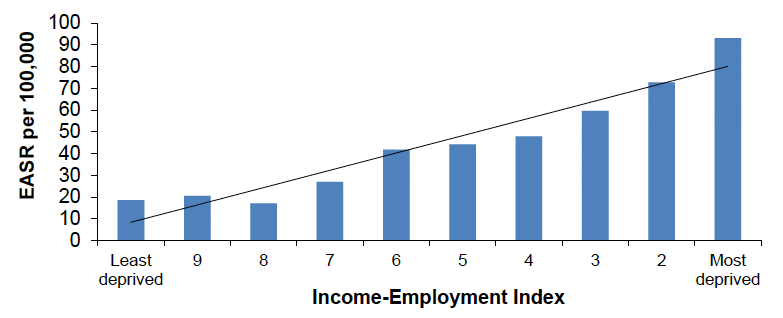
Trends in relative inequalities
Relative inequalities in alcohol-specific deaths have fluctuated since the start of the series in 1997. The RII in 2018 is the lowest in the series (1.79).
Figure 8.2
Relative Index of Inequality (RII): Alcohol-specific mortality 45-74y Scotland 1997-2018
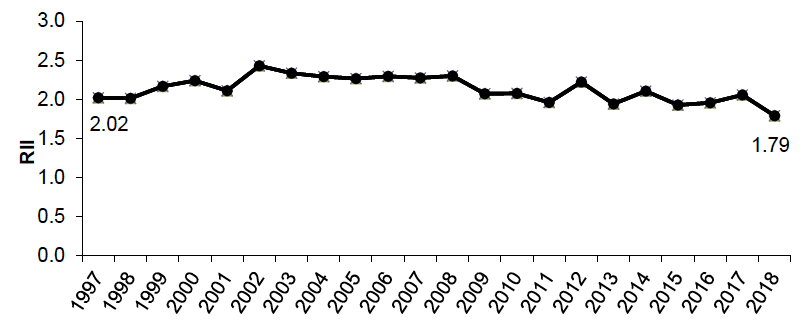
Over time the relative range between the most and least deprived areas has fluctuated, peaking in 2002 when death rates were fourteen times higher in the most deprived areas. In 2018, death rates were five times higher in the most deprived areas, the lowest in the time series.
Trends in absolute inequalities
Although the rate of alcohol-specific deaths in the least deprived areas has remained reasonably static since 1997, there has been considerable change in the rate in the most deprived areas. This has largely driven changes in the absolute gap.
Following an increase from 104.4 to 198.8 per 100,000 between 1997 and 2002, there was a general decrease in the alcohol-specific mortality rate in the most deprived areas until 2013 (83.2 per 100,000). Since then, the rate has fluctuated between 93.1 and 114.7 per 100,000, with the rate for 2018 (93.1 per 100,000) being the second lowest in the time series.
Figure 8.3
Absolute Gap: Alcohol-specific mortality 45-74y Scotland 1997-2018 (European Age-Standardised Rates per 100,000)
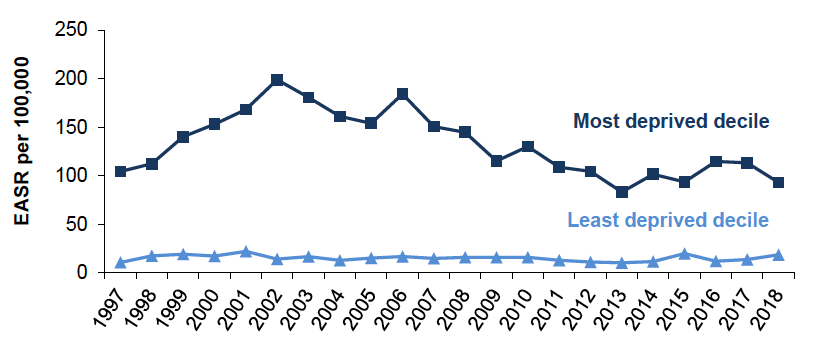
All-cause mortality aged 15-44 years
Trends in all-cause mortality aged 15-44
There were a total of 2,220 deaths of people aged 15-44 in Scotland in 2018.
There was an overall decrease in the mortality rate from the start of the time series to 2014, when rates reached a low of 96.8 per 100,000. Since then, the mortality rate of those aged 15-44 has risen and in 2018 it was similar to the rate in 1997 (114.5 per 100,000 and 116.3 per 100,000 respectively).
Table 9.1: Trends in all-cause mortality (aged 15-44), 1997-2018
| Number of all-causes deaths | Target population size | Rate per 100,000 (EASR) | |
|---|---|---|---|
| 1997 | 2,440 | 2,158,030 | 116.3 |
| 1998 | 2,507 | 2,142,787 | 119.4 |
| 1999 | 2,507 | 2,129,794 | 119.0 |
| 2000 | 2,501 | 2,118,568 | 118.7 |
| 2001 | 2,509 | 2,111,242 | 119.0 |
| 2002 | 2,566 | 2,102,670 | 122.0 |
| 2003 | 2,461 | 2,094,408 | 116.9 |
| 2004 | 2,409 | 2,088,563 | 114.7 |
| 2005 | 2,305 | 2,091,415 | 109.3 |
| 2006 | 2,482 | 2,091,581 | 118.3 |
| 2007 | 2,461 | 2,097,902 | 117.5 |
| 2008 | 2,443 | 2,096,495 | 117.5 |
| 2009 | 2,389 | 2,092,065 | 115.1 |
| 2010 | 2,229 | 2,087,635 | 108.6 |
| 2011 | 2,262 | 2,092,311 | 110.8 |
| 2012 | 2,071 | 2,077,902 | 102.8 |
| 2013 | 1,990 | 2,064,867 | 100.1 |
| 2014 | 1,904 | 2,053,897 | 96.8 |
| 2015 | 1,976 | 2,053,401 | 101.2 |
| 2016 | 2,194 | 2,054,055 | 112.5 |
| 2017 | 2,068 | 2,048,063 | 107.1 |
| 2018 | 2,220 | 2,044,305 | 114.5 |
The 2,220 deaths of those age 15-44 in 2018 included: 370 probable suicides, 28 deaths from assault and 723 drug-related deaths. While the rates of probable suicide in this age group had generally been declining in recent years there was an increase in 2018 to 18.28 per 100,000, the highest figure since 2012 (18.34 per 100,000). Rates of death from assault have increased slightly from a low of 1.04 per 100,000 in 2014, but have generally been lower in the last decade that at the start of the series. Drug-related deaths have shown large increases since the beginning of the time series in 1997. In 2018, the drug-related death rate was 37.33 per 100,000, this compares with 8.91 per 100,000 in 1997.
Table 9.2: Trends in deaths from assault, drugs and suicide (aged 15-44), 1997-2018
| Deaths from assault | Drug related deaths | Suicides | ||||
|---|---|---|---|---|---|---|
| Number | EASR per 100,000 | Number | EASR per 100,000 | Number | EASR per 100,000 | |
| 1997 | 56 | 2.6 | 196 | 8.9 | 518 | 23.9 |
| 1998 | 65 | 3.0 | 227 | 10.6 | 526 | 24.4 |
| 1999 | 86 | 4.0 | 274 | 12.9 | 529 | 24.7 |
| 2000 | 60 | 2.9 | 268 | 12.7 | 541 | 25.6 |
| 2001 | 63 | 3.0 | 289 | 13.8 | 531 | 25.3 |
| 2002 | 76 | 3.6 | 345 | 16.7 | 539 | 25.7 |
| 2003 | 71 | 3.4 | 282 | 13.6 | 456 | 21.8 |
| 2004 | 78 | 3.8 | 311 | 15.2 | 475 | 22.7 |
| 2005 | 50 | 2.4 | 277 | 13.4 | 436 | 21.0 |
| 2006 | 83 | 4.0 | 350 | 17.1 | 435 | 20.9 |
| 2007 | 54 | 2.6 | 392 | 19.1 | 453 | 21.8 |
| 2008 | 53 | 2.5 | 477 | 23.3 | 480 | 23.4 |
| 2009 | 47 | 2.3 | 436 | 21.3 | 432 | 20.8 |
| 2010 | 54 | 2.6 | 384 | 18.9 | 423 | 20.5 |
| 2011 | 53 | 2.6 | 454 | 22.5 | 420 | 20.5 |
| 2012 | 37 | 1.9 | 416 | 20.8 | 375 | 18.3 |
| 2013 | 35 | 1.7 | 354 | 17.9 | 356 | 17.7 |
| 2014 | 22 | 1.0 | 416 | 21.1 | 309 | 15.4 |
| 2015 | 28 | 1.4 | 442 | 22.8 | 306 | 15.3 |
| 2016 | 34 | 1.7 | 568 | 29.2 | 329 | 16.2 |
| 2017 | 40 | 2.0 | 581 | 30.1 | 305 | 15.1 |
| 2018 | 28 | 2.0 | 723 | 37.3 | 370 | 18.3 |
Inequalities in all-cause mortality aged 15-44, 2018
The mortality rate amongst people aged 15-44 years is 8 times higher in the most deprived areas (273.3 per 100,000) compared to the least deprived (36.3 per 100,000).
Figure 9.1
Mortality amongst those aged 15-44 years by Income-Employment Index, Scotland 2018 (European Age-Standardised Rates per 100,000)
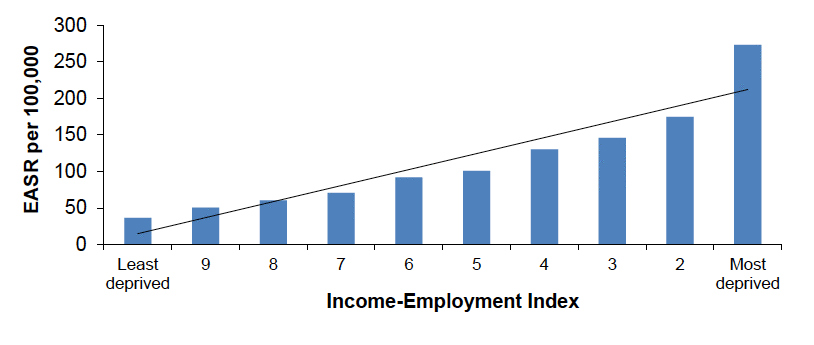
Trends in relative inequalities
There has been an overall increase in relative inequalities over time and they are currently at their highest point in the time series (1.97).
Figure 9.2
Relative index of inequality (RII): mortality aged 15-44y Scotland 1997-2018
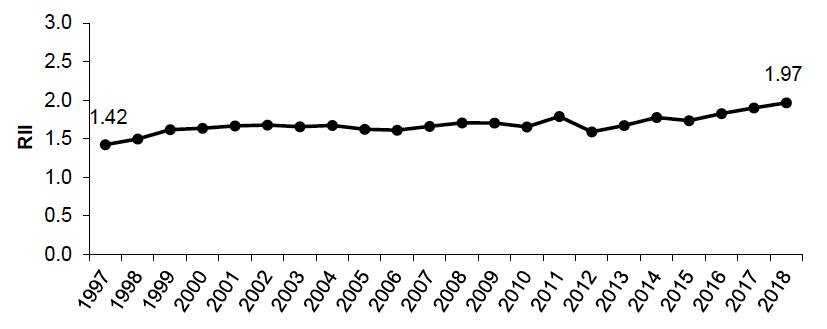
Between 1997 and 2017, death rates ranged from 4-7 times higher in the most deprived areas compared to the least deprived. In 2018 deaths for those aged 15-44 years were 8 times higher in the most deprived areas compared to the least deprived areas.
Trends in absolute inequalities
The absolute gap between the most and least deprived areas in all-cause mortality between ages 15 and 44 reached its lowest level in 2013 (a gap of 159.6 per 100,000). In each year since 2013, the mortality rate between ages 15 and 44 in the most deprived areas increased and the gap between the most and least deprived areas widened to 237 per 100,000 in 2018.
Figure 9.3
Absolute Gap: Mortality 15-44y, Scotland 1997-2018 (European Age-Standardised Rates per 100,000)
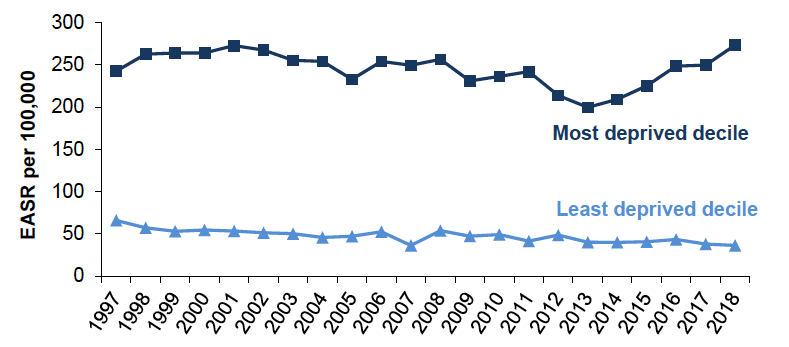
Low Birthweight
Trends in low birthweight
Almost 2,700 low birthweight babies were born in Scotland in 2018.
The percentage of babies born with a low birthweight has fluctuated slightly since 1996. Between 1996 and 2007 the percentage of babies born with a low birthweight ranged between 5.5% and 6.0%. Since 2008 the figures have generally been lower, ranging from 5.0% to 5.6%.
Table 10.1: Trends in low birthweight, 1996-2018
| Number of low birthweight babies | Target population size | % of live singleton births | |
|---|---|---|---|
| 1996 | 3,057 | 55,683 | 5.5 |
| 1997 | 3,132 | 56,787 | 5.5 |
| 1998 | 3,087 | 54,987 | 5.6 |
| 1999 | 3,083 | 52,591 | 5.9 |
| 2000 | 2,888 | 50,911 | 5.7 |
| 2001 | 2,832 | 49,625 | 5.7 |
| 2002 | 2,894 | 48,798 | 5.9 |
| 2003 | 3,006 | 49,925 | 6.0 |
| 2004 | 3,016 | 51,709 | 5.8 |
| 2005 | 3,049 | 51,309 | 5.9 |
| 2006 | 2,919 | 52,298 | 5.6 |
| 2007 | 3,079 | 55,131 | 5.6 |
| 2008 | 3,124 | 56,793 | 5.5 |
| 2009 | 2,878 | 55,854 | 5.2 |
| 2010 | 2,798 | 55,914 | 5.0 |
| 2011 | 2,926 | 55,808 | 5.2 |
| 2012 | 2,765 | 55,124 | 5.0 |
| 2013 | 2,676 | 53,042 | 5.0 |
| 2014 | 2,766 | 54,265 | 5.1 |
| 2015 | 2,807 | 52,703 | 5.3 |
| 2016 | 2,755 | 52,307 | 5.3 |
| 2017 | 2,820 | 50,625 | 5.6 |
| 2018 | 2,666 | 49,049 | 5.4 |
Inequalities in low birthweight 2018
In 2018, 8.1% of live singleton births in the most deprived areas were recorded as low birthweight. This is more than double the percentage in the least deprived areas (3.9%).
Figure 10.1
Low birthweight babies in Scotland by Income-Employment index 2018 (as percentage of live singleton births)
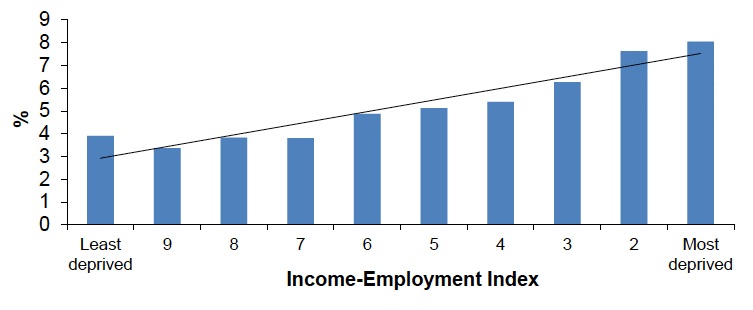
Trends in relative inequalities
Relative inequalities in low birthweight were higher in 2018 than those observed at the start of the time series (0.99 and 0.84 respectively). The RII values between 1997 and 2006 tended to be higher than those observed in the last decade, however, the RII in 2018 was the highest since 2006.
Figure 10.2
Relative index of inequality (RII): Low birthweight babies in Scotland 1996-2018
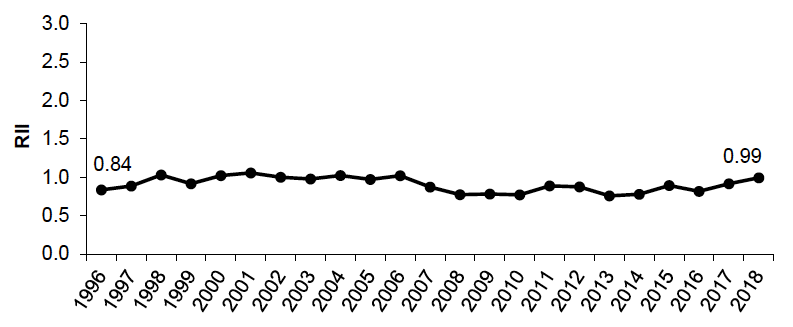
Trends in absolute inequalities
Overall, the absolute gap between the most and least deprived areas has reduced from its widest point in 2004 (5.7 percentage points). However, the gap has fluctuated in recent years, ranging from 3.1-4.3 percentage points over the last 10 years.
The narrowing and widening of the gap has tended to be driven by changes in the most deprived decile, as the least deprived decile has remained broadly stable since the beginning of the time series.
Figure 10.3
Absolute Gap:Low birthweight babies in Scotland 1996-2018 (as percentage of live singleton births)
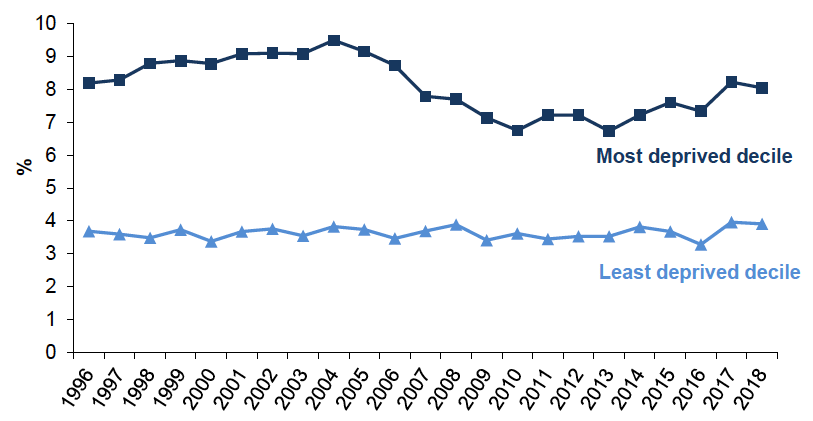
Healthy Birthweight
Trends in healthy birthweight babies
In each year of the time series, either 89% or 90% of babies have been of healthy birthweight. For the past seven years the value has been 90%.
Table 11.1: Trends in healthy birthweight, 1996-2018
| Number appropriate for gestational age1 | Target population size1 | % of live singleton births | |
|---|---|---|---|
| 1996 | 49,829 | 55,581 | 89.7 |
| 1997 | 50,941 | 56,701 | 89.8 |
| 1998 | 49,163 | 54,910 | 89.5 |
| 1999 | 46,930 | 52,521 | 89.4 |
| 2000 | 45,162 | 50,833 | 88.8 |
| 2001 | 44,256 | 49,547 | 89.3 |
| 2002 | 43,438 | 48,703 | 89.2 |
| 2003 | 44,411 | 49,812 | 89.2 |
| 2004 | 45,757 | 51,596 | 88.7 |
| 2005 | 45,472 | 51,176 | 88.9 |
| 2006 | 46,530 | 52,162 | 89.2 |
| 2007 | 48,930 | 54,942 | 89.1 |
| 2008 | 50,540 | 56,602 | 89.3 |
| 2009 | 49,654 | 55,656 | 89.2 |
| 2010 | 50,038 | 55,818 | 89.6 |
| 2011 | 49,788 | 55,730 | 89.3 |
| 2012 | 49,235 | 55,004 | 89.5 |
| 2013 | 47,488 | 52,857 | 89.8 |
| 2014 | 48,554 | 53,913 | 90.1 |
| 2015 | 47,158 | 52,387 | 90.0 |
| 2016 | 46,587 | 51,754 | 90.0 |
| 2017 | 45,041 | 50,048 | 90.0 |
| 2018 | 44,123 | 48,803 | 90.4 |
1. Excludes records that could not be assigned an income employment decile
Inequalities in healthy birthweight babies 2018
In 2018, there was a marginal difference between the least and the most deprived areas in terms of the proportion of healthy births (90.3% versus 90.4% respectively)
Figure 11.1
Babies appropriate for gestational age in Scotland by Income-Employment index 2018 (as percentage of live singleton births)
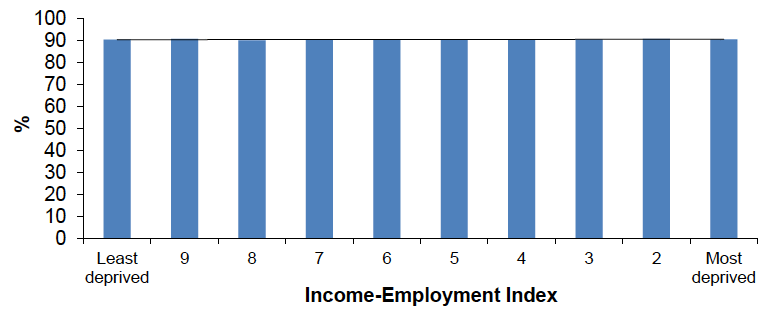
Trends in relative inequalities
Relative inequalities have been consistently low over the times series. The RII for 2018 is at 0.00, suggesting that there is no relative inequality for this indicator.
Figure 11.2
Relative index of inequality (RII): Babies appropriate for gestational age in Scotland 1996-2018
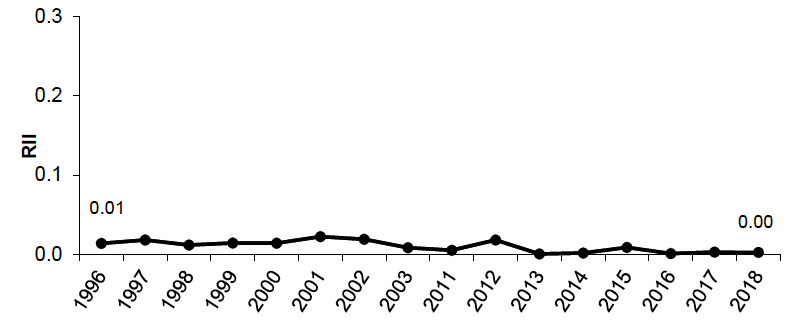
Trends in absolute inequalities
The absolute gap between the percentage of healthy birthweight babies in the most and least deprived deciles has been consistently low across the full time series.
Figure 11.3
Absolute Gap: Babies appropriate for gestational age in Scotland 1996-2018 (as percentage of live singleton births)
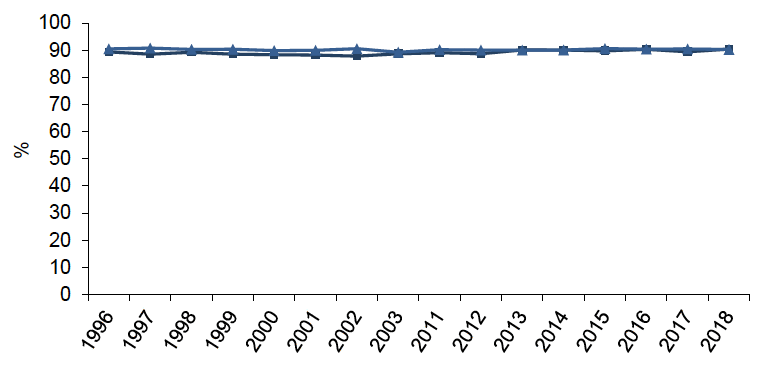
Drug-related hospital admissions aged under 75 years
Trends in drug-related hospital admissions
In 2017/18, 9,270 individuals under the age of 75 were admitted to hospital for drug-related issues.
The rate of drug-related hospital admissions, which is based on the number of patients admitted to general acute and psychiatric specialties for drug misuse in each financial year, has shown a general upward trend since 1996/97 and is currently over three times higher than at the start of the time series.
Table 12.1: Trends in drug-related hospital admissions (aged <75), 1996/97-2017/18
| Number of patients admitted1 | Population | Rate per 100,000 (EASR) | |
|---|---|---|---|
| 1996/97 | 3,366 | 4,754,906 | 64.0 |
| 1997/98 | 3,801 | 4,740,269 | 73.6 |
| 1998/99 | 4,395 | 4,729,975 | 86.2 |
| 1999/00 | 4,734 | 4,721,298 | 94.1 |
| 2000/01 | 4,851 | 4,708,667 | 97.6 |
| 2001/02 | 5,205 | 4,703,661 | 105.7 |
| 2002/03 | 5,415 | 4,701,958 | 110.7 |
| 2003/04 | 5,124 | 4,702,431 | 106.0 |
| 2004/05 | 5,292 | 4,714,233 | 109.7 |
| 2005/06 | 5,019 | 4,735,320 | 104.0 |
| 2006/07 | 5,262 | 4,752,425 | 108.8 |
| 2007/08 | 5,790 | 4,783,452 | 119.3 |
| 2008/09 | 6,120 | 4,811,453 | 125.9 |
| 2009/10 | 6,009 | 4,835,007 | 124.0 |
| 2010/11 | 6,435 | 4,858,058 | 132.6 |
| 2011/12 | 6,384 | 4,888,316 | 131.1 |
| 2012/13 | 6,033 | 4,895,114 | 124.5 |
| 2013/14 | 6,624 | 4,903,074 | 137.5 |
| 2014/15 | 6,984 | 4,914,362 | 144.8 |
| 2015/16 | 7,839 | 4,935,283 | 162.4 |
| 2016/17 | 8,616 | 4,962,391 | 178.6 |
| 2017/18 | 9,270 | 4,976,829 | 192.2 |
1. Patients who have been admitted to hospital for drug misuse multiple times in the same
financial year will only be counted once per year.
Inequalities in drug-related hospital admissions, 2017/18
In 2017/18, the admission rate in Scotland's most deprived areas was 21 times greater than that of the least deprived (624.5 cases per 100,000 compared to 29.2 per 100,000).
Figure 12.1
Drug-related hospital admissions <75y by Income-Employment Index, Scotland 2017/18 (European Age-Standardised Rates per 100,000)
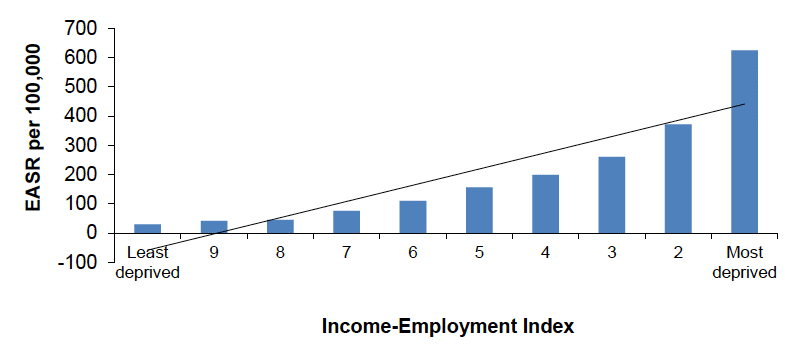
Trends in relative inequalities
Relative inequality levels for patients with drug-related hospital admissions have fluctuated over time. Although they have decreased from a high of 3.05 in 1998/99 they have increased every year for the last five years and the RII for 2017/18 (2.90) is higher than at the start of the time series (2.77).
Figure 12.2
Relative Index of Inequality (RII): Drug-related hospital admissions <75y Scotland 1996/97-2017/18
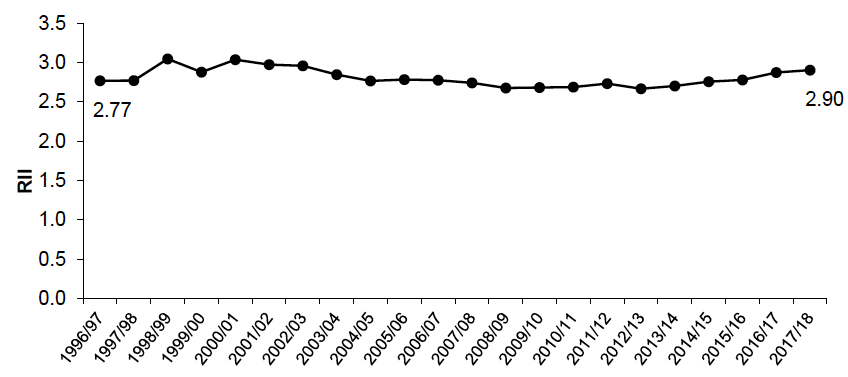
Since 1996/97 admission rates (aged <75) have ranged from 15-28 times higher in the most deprived areas compared to the least deprived areas.
Trends in absolute inequalities
The absolute gap in rates between those living in the most deprived areas and the least deprived areas has increased overall since the start of the time series. After an initial increase between 1996/97 and 1998/99 the absolute gap remained relatively stable, ranging from 309.6 - 385.2 per 100,000 between 1999/00 and 2012/13 before increasing in each of the past five years. In 2017/18 the absolute gap was at its highest level at 595.3 per 100,000. These fluctuations have mainly been driven by changes in drug-related hospital admissions in the most deprived areas, with drug-related hospital admissions in the least deprived areas remaining fairly static over time.
Figure 12.3
Absolute Gap: Drug-related hospital admissions <75y Scotland 1996/97-2017/18 (European Age-Standardised Rates per 100,000)
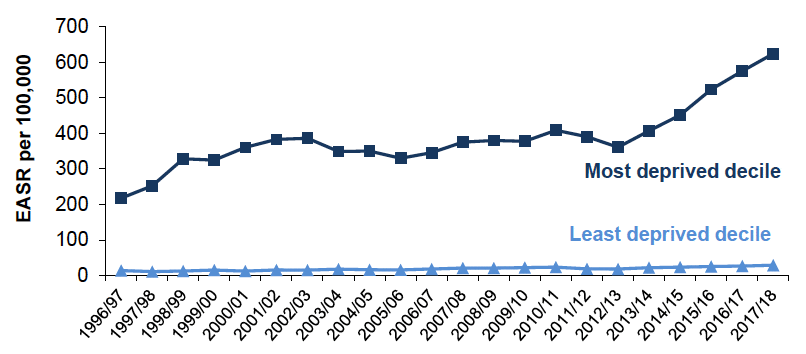
Contact
Email: morag.shepherd@gov.scot
There is a problem
Thanks for your feedback